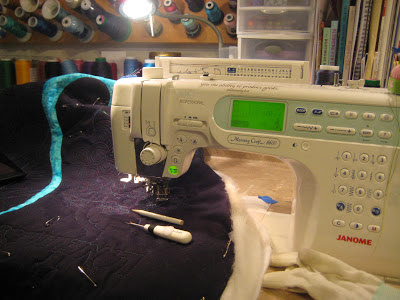Knowing your machine is so very important to doing good quilting. It just isn't possible to quilt well without putting in the time to learn its foibles and strengths. Otherwise you'll spend so much time adjusting and tweaking and probably ripping out stitches that you might give up on quilting before you have a chance to get good at it.
- Learn your machine's body- By this I mean what feet work best, when. How is it set up? Are you used to it being flush or set into a table? What setting works the best for whatever project and use? What accessories help you quilt the best? Feed dogs up or down? The best way to know this is to use that machine! Make some practice pieces, make the dog a quilt. Give yourself permission to fail in the pursuit of bettering your skills.
- Learn your machines likes and dislikes-How does it react to different threads or fabrics? How picky is it about the needle size or type when you use different fabrics. My machine for example, hates sewing in a straight backwards line, so I orient my work so there's always some side to side movement. Some folks have trouble quilting multiple layers of white-on-white or glitter frosted fabrics. (This may just be a need for a different needle.) At what speed does it have the best tension? Do some fabric/thread combinations change it sound? (We'll talk more about sound below) In my Christmas lights video, I talk about the different sound made when stitching on painted fabrics.
- Learn what makes your machine hum- Or really, what makes your machine go ca-thunk, ca-thunk! Learn the sounds of something amiss. Recently, I was sewing along when something sounded wrong. Not a ca-chunk, but a little rattly sound. I've gotten to know my machine pretty well, so I knew something was amiss with the bobbin. I actually had a good idea exactly what it was and when I opened the bobbin case, I found I was right!
As seen in the above picture, I found that my almost empty bobbin now had two ends. The end of thread had come loose from the hole where it had been wound. This allowed that end to interfere with the looping of the top thread and the usable part of the bobbin thread. The quilting still looked great, but it sounded wrong and the back was getting all loopy.(That's a genuine Janome Cherry Blossom Bobbin
How well do you know your machine? Take it for a good test drive! How about the manual? If you have a Bernina, they've got the best educational materials out there for their machines. If you have a Janome, you might have to do a lot of figuring out on your own. Though they are getting better, I am told, with their higher end machines.
And now that we've talked so intimately, I've got a confession. The quilt on my bed came from Walmart. But I have non-quilt worthy traffic on my bed a lot!
I also have the world's largest cat. Or so the camera angle would lead you to believe. He also uses his claws to get up on the bed. My little guy is quilt-worthy, but his use of my bed is not. He's asleep due to the onset of stomach flu as we later found out. Maybe I'll get some quilting done this weekend. I certainly hope you will!




Amy thanks for your great comments re knowing your machine. I have Janomes and yes you definitely have to work out each individual machine's quirks. Your instructions are so clear and concise that I am planning to get to know my machine more today! (and hopefully get the FMQ working for ME!
ReplyDeleteThanks so much! Enjoy your machine today!
DeleteI have an Elna 3500 and it doesn't give good insrtuction for machine quilting in the manual. I started on a big quilt. Had to stop as the stitches look terrible!!!
ReplyDelete